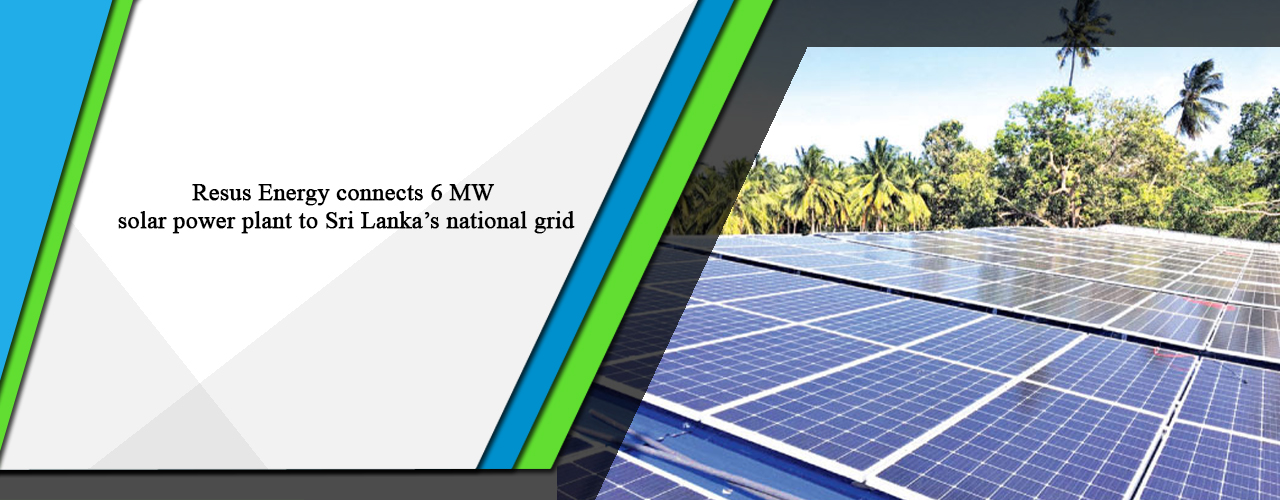Resus Energy connects 6 MW solar power plant to Sri Lanka’s national grid
Resus Energy PLC in Sri Lanka, which is a renewable-energy company, has further expanded its portfolio by connecting a 6 megawatt (MW) ground-mounted solar photovoltaic (PV) station to the country’s national grid.
The respective solar plant is located in Rideemaliyadda and connected to the Mahiyanganaya grid substation with the development rights of these projects being secured under the Sri Lankan government’s Soorya Balasangramaya tender floated to procure 90 x 1 MW Solar PV projects.
According to local media reports, built at a cost of over Rs. 1 billion with state-of-the-art equipment encompassing tier-1 solar PV panels, inverters, and other auxiliary equipment, the power station is expected to generate about 9 million units of electricity (9 GWh) annually.
This Rideemaliyadda plant is Resus Energy’s second solar PV site and together with its first site in Siyambalanduwa, Resus supplies 8 MW of solar power to the national grid.
Resus Energy Managing Director Kishan Nanayakkara has been quoted as saying, “This country is paying dearly because of the renewable energy shortage. We are having blackouts impacting people’s lives and business and at the same time idling thermal plants due to fuel shortage. That’s ironic. Our economy is pushed to a perilous state for having to pay astronomical prices for fuel to even have a limited operation of our thermal plants.
“Resus Energy’s newly connected solar PV station gives a huge economic benefit to the nation, supplying electricity at about Rs. 15 a unit for the next 20 years, which is below the Ceylon Electricity Board’s (CEB) current average selling price, enabling it to make a profit from each unit. Comparatively, the fuel cost of the Puttalam Coal Plant, the cheapest thermal plant, alone is over two-and-a-half times our unit cost and is over six times in the case of diesel and furnace oil plants.”
Resus currently operates 11 utility-scale grid-connected power stations with an aggregate capacity of about 24 MW and estimated annual energy generation of over 60 GWh.
“Sri Lanka being a signatory to the 2015 Paris Agreement on climate change is obligated to the implementation of Sustainable Development Goals (SDGs) in which SDG 7 is the provision of clean and affordable energy. Through our Nationally Determined Contributions (NDC) we have also pledged to reduce emissions by 30%, with 20% to come from the energy sector. Renewable energy is a huge element in meeting our promise to the world made through the Paris Accord and NDCs,” Nanayakkara has added.
OSL take:
Sri Lanka’s power industry has become a hotspot for business/investment opportunities in the country. The ongoing power crisis has resulted in increasing the demand for additional power generation mechanisms, especially in the renewable energy generation sector. The government of Sri Lanka has also adopted a policy of increasing the country’s renewable energy generation capacity to 70% of the country’s energy mix by 2030. Local businesses engaged in the renewable energy generation sector continue to record profits indicating the growing business potential in the sector. Many international companies have already expressed interest in entering Sri Lanka’s renewable energy generation sector. Given the positive growth in the sector, foreign businesses/investors could confidently explore the growing opportunities in Sri Lanka’s renewable energy generation sector.
| Article Code : | VBS/AT/13062022/Z_2 |

